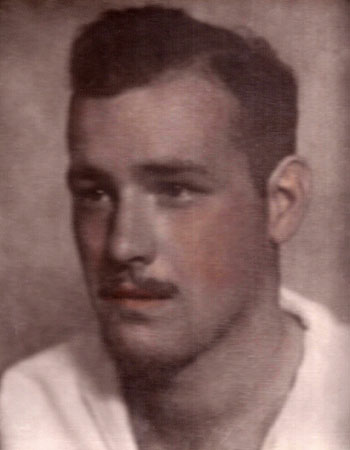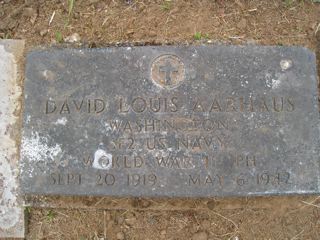David Louis Aarhaus was a proud member of the 4th Marine Regiment upon the US Canopus in the Philippine Islands in 1942. His title was Ship Fitter, Second Class.
David lost his life while on active duty, protecting his own, and was Killed In Action in Corregidor, Philippines. For his valor he received the honor of a Purple Heart.
David Louis Aarhaus
Rank/Rate Ship Fitter, Second Class
Service Number 385 80 16
Birth Date September 20, 1919
From Elma, Washington
Decorations Purple Heart
Ship USS Canopus (AS-9)
Date of Death May 6, 1942
Location Corregidor, Philippine Islands
Circumstances Killed in Action with the 4th Marine Regiment
Remarks David was born in Hoquiam, Washington.
U.S. Rosters of World War II Dead, 1939-1945 about David Louis Aarhaus
Name: David Louis Aarhaus
Gender: Male
Race: White
Religion: Protestant
Disposition: According to next of kin
Service Branch: Navy
Rank: Shipfitter 2nd Class
Service Number: 3858016
World War II Navy, Marine Corps, and Coast Guard Casualties, 1941-1945 about David Louis Aarhaus
Name: David Louis Aarhaus
Relative Name: Mr. Louis Ambrose Aarhaus
Relative Relationship: Father
State: Washington
Country: United States
Type of Casualty: Killed In Action
Roll: ww2c_27
Service history
1922–1941
Canopus reported to Submarine Force, Atlantic Fleet, and remained at Boston until 9 November 1922, when she sailed for further fitting out at Coco Solo, Canal Zone, and San Pedro, California, her base as tender to the submarines of Division 9 until 17 July 1923.
Sailing to Pearl Harbor, Canopus tended Submarine Division 17 of the Battle Force with whom she sailed for permanent duty with the Asiatic Fleet in September 1924. Canopus with her squadron of submarines arrived in the Philippines on 4 November 1924. Canopus began her regular schedule of services in Manila Bay, and each summer based with the fleet at Tsingtao, China, with occasional training cruises to various Chinese and Japanese ports, and to the British and French colonies. Between 1927 and 1931, the tender was flagship of submarine divisions, Asiatic Fleet, and later was attached to Submarine Division 10, and was flagship of Submarine Squadron 5.
World War II, 1941–1942
On 7 December 1941, Canopus, aging but able, lay at Cavite Navy Yard, as tender to Submarine Squadron 20. In the days that followed, her men worked day and night to repair ships damaged in the daily air raids as well as to keep her brood of submarines at sea. With the Army falling back on Manila, Canopus sailed to Mariveles Bay at the tip of Bataan on Christmas Day. On 29 December 1941 she received her first direct bomb hit. A 500-pound armor-piercing bomb penetrated all decks and exploded on the propeller shaft housing. Six sailors were killed mostly from scalding and fires started in the engine rooms and magazines. The six men were buried at sea at 1735 hours in Mariveles Bay at the tip of Bataan. On 1 January 1942 she received a second direct bomb hit. This time a fragmentation bomb which exploded near the top of the towering smokestack resulting in substantial damage to the ship and injuries to 16 men of the gun crews.
Disguised as a bombed out, listing, abandoned hulk, smoke pots were placed around the ship and giving the appearance of an abandoned hulk by day, while the ship hummed with activity by night. Her crew worked at a fevered pace repairing the smaller ships also left behind and keeping the submarines in action.
Just before the New Year, the last of the submarines left Canopus, but she never quit as she cared for small craft and equipment of the Army and Navy, sent her men into battle in the improvised naval battalion which fought on Bataan, and converted her own launches into miniature gunboats dubbed Mickey Mouse Battleships which attacked the Japanese moving south near the shore. But the overwhelming Japanese strength could not be held off forever, and upon the surrender of Bataan on the night of 8/9 April, 1942 CANOPUS was ordered scuttled in Mariveles Bay, Bataan, to deny her use to the enemy. On 9 April, she was backed off into deep water under her own power and the veteran whom the Japanese could not sink ended a lifetime of service to the Navy when she was laid to rest by her own men.
221 of her crewmen were evacuated to Corregidor on February 28, 1942 and served with the Marines 1st, 2nd, and 3rd Battalions on beach defenses. The final 327 crewmen were also evacuated to Corregidor and served in the 4th Marine Regiment's 4th Battalion Reserves (Provisional)which fought gallantly during the final battle for the island fortress. Nearly all Canopus crewmen were captured at the fall of Corregidor and spent the rest of the war in Japanese POW Camps in the Philippines and the Asia mainland.
212 were Killed/missing in Action.
David Louis Aarhaus was a proud member of the 4th Marine Regiment upon the US Canopus in the Philippine Islands in 1942. His title was Ship Fitter, Second Class.
David lost his life while on active duty, protecting his own, and was Killed In Action in Corregidor, Philippines. For his valor he received the honor of a Purple Heart.
David Louis Aarhaus
Rank/Rate Ship Fitter, Second Class
Service Number 385 80 16
Birth Date September 20, 1919
From Elma, Washington
Decorations Purple Heart
Ship USS Canopus (AS-9)
Date of Death May 6, 1942
Location Corregidor, Philippine Islands
Circumstances Killed in Action with the 4th Marine Regiment
Remarks David was born in Hoquiam, Washington.
U.S. Rosters of World War II Dead, 1939-1945 about David Louis Aarhaus
Name: David Louis Aarhaus
Gender: Male
Race: White
Religion: Protestant
Disposition: According to next of kin
Service Branch: Navy
Rank: Shipfitter 2nd Class
Service Number: 3858016
World War II Navy, Marine Corps, and Coast Guard Casualties, 1941-1945 about David Louis Aarhaus
Name: David Louis Aarhaus
Relative Name: Mr. Louis Ambrose Aarhaus
Relative Relationship: Father
State: Washington
Country: United States
Type of Casualty: Killed In Action
Roll: ww2c_27
Service history
1922–1941
Canopus reported to Submarine Force, Atlantic Fleet, and remained at Boston until 9 November 1922, when she sailed for further fitting out at Coco Solo, Canal Zone, and San Pedro, California, her base as tender to the submarines of Division 9 until 17 July 1923.
Sailing to Pearl Harbor, Canopus tended Submarine Division 17 of the Battle Force with whom she sailed for permanent duty with the Asiatic Fleet in September 1924. Canopus with her squadron of submarines arrived in the Philippines on 4 November 1924. Canopus began her regular schedule of services in Manila Bay, and each summer based with the fleet at Tsingtao, China, with occasional training cruises to various Chinese and Japanese ports, and to the British and French colonies. Between 1927 and 1931, the tender was flagship of submarine divisions, Asiatic Fleet, and later was attached to Submarine Division 10, and was flagship of Submarine Squadron 5.
World War II, 1941–1942
On 7 December 1941, Canopus, aging but able, lay at Cavite Navy Yard, as tender to Submarine Squadron 20. In the days that followed, her men worked day and night to repair ships damaged in the daily air raids as well as to keep her brood of submarines at sea. With the Army falling back on Manila, Canopus sailed to Mariveles Bay at the tip of Bataan on Christmas Day. On 29 December 1941 she received her first direct bomb hit. A 500-pound armor-piercing bomb penetrated all decks and exploded on the propeller shaft housing. Six sailors were killed mostly from scalding and fires started in the engine rooms and magazines. The six men were buried at sea at 1735 hours in Mariveles Bay at the tip of Bataan. On 1 January 1942 she received a second direct bomb hit. This time a fragmentation bomb which exploded near the top of the towering smokestack resulting in substantial damage to the ship and injuries to 16 men of the gun crews.
Disguised as a bombed out, listing, abandoned hulk, smoke pots were placed around the ship and giving the appearance of an abandoned hulk by day, while the ship hummed with activity by night. Her crew worked at a fevered pace repairing the smaller ships also left behind and keeping the submarines in action.
Just before the New Year, the last of the submarines left Canopus, but she never quit as she cared for small craft and equipment of the Army and Navy, sent her men into battle in the improvised naval battalion which fought on Bataan, and converted her own launches into miniature gunboats dubbed Mickey Mouse Battleships which attacked the Japanese moving south near the shore. But the overwhelming Japanese strength could not be held off forever, and upon the surrender of Bataan on the night of 8/9 April, 1942 CANOPUS was ordered scuttled in Mariveles Bay, Bataan, to deny her use to the enemy. On 9 April, she was backed off into deep water under her own power and the veteran whom the Japanese could not sink ended a lifetime of service to the Navy when she was laid to rest by her own men.
221 of her crewmen were evacuated to Corregidor on February 28, 1942 and served with the Marines 1st, 2nd, and 3rd Battalions on beach defenses. The final 327 crewmen were also evacuated to Corregidor and served in the 4th Marine Regiment's 4th Battalion Reserves (Provisional)which fought gallantly during the final battle for the island fortress. Nearly all Canopus crewmen were captured at the fall of Corregidor and spent the rest of the war in Japanese POW Camps in the Philippines and the Asia mainland.
212 were Killed/missing in Action.
Family Members
Sponsored by Ancestry
Advertisement
Explore more
Sponsored by Ancestry
Advertisement







